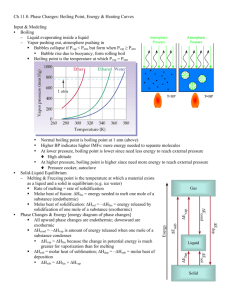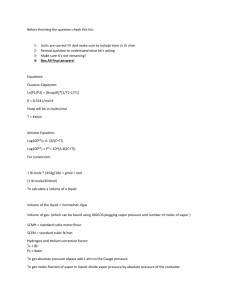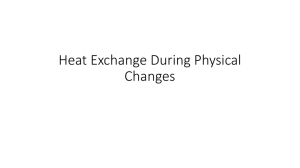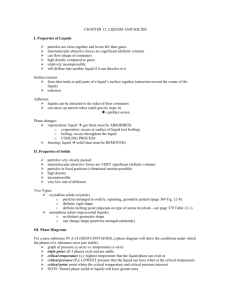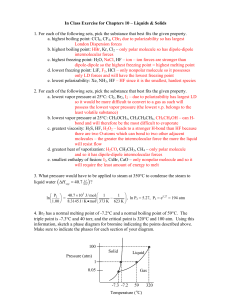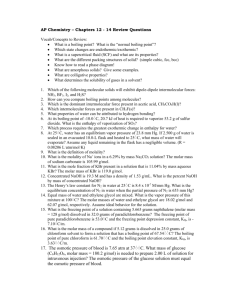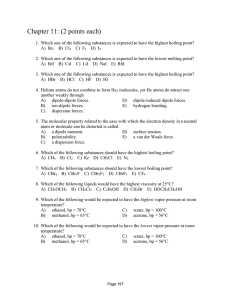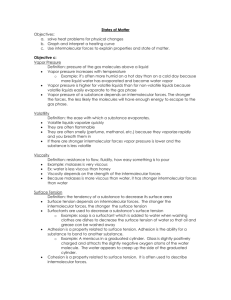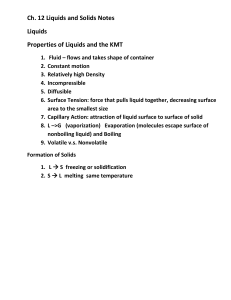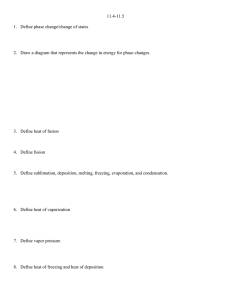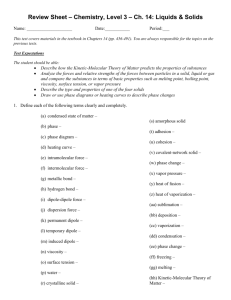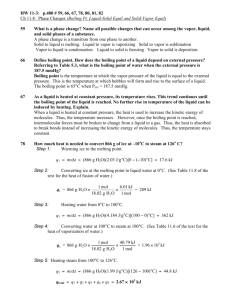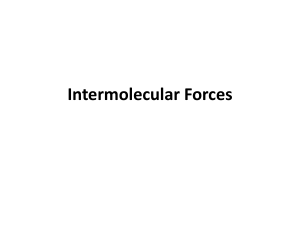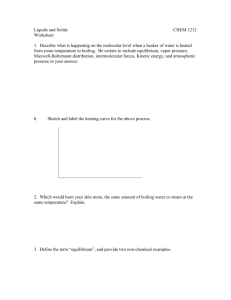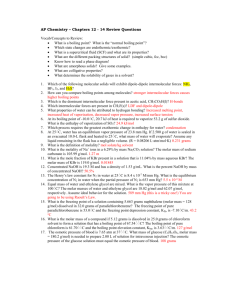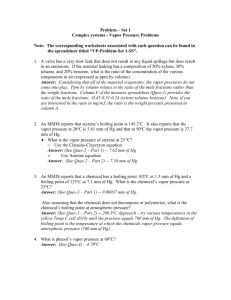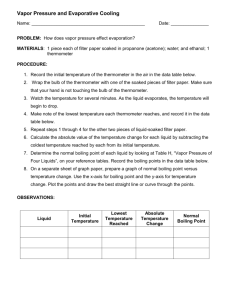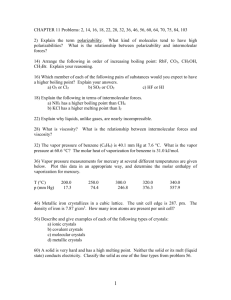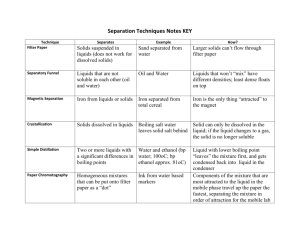Accelerated Chemistry – Test Study Guide Liquids and Solids
advertisement
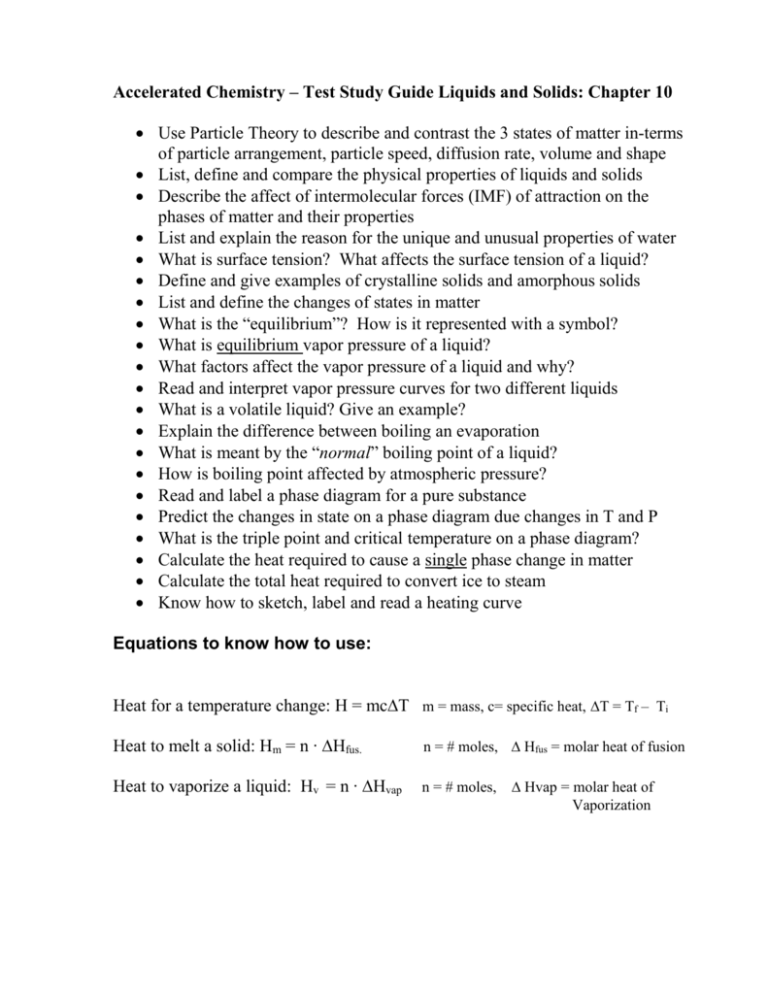
Accelerated Chemistry – Test Study Guide Liquids and Solids: Chapter 10 Use Particle Theory to describe and contrast the 3 states of matter in-terms of particle arrangement, particle speed, diffusion rate, volume and shape List, define and compare the physical properties of liquids and solids Describe the affect of intermolecular forces (IMF) of attraction on the phases of matter and their properties List and explain the reason for the unique and unusual properties of water What is surface tension? What affects the surface tension of a liquid? Define and give examples of crystalline solids and amorphous solids List and define the changes of states in matter What is the “equilibrium”? How is it represented with a symbol? What is equilibrium vapor pressure of a liquid? What factors affect the vapor pressure of a liquid and why? Read and interpret vapor pressure curves for two different liquids What is a volatile liquid? Give an example? Explain the difference between boiling an evaporation What is meant by the “normal” boiling point of a liquid? How is boiling point affected by atmospheric pressure? Read and label a phase diagram for a pure substance Predict the changes in state on a phase diagram due changes in T and P What is the triple point and critical temperature on a phase diagram? Calculate the heat required to cause a single phase change in matter Calculate the total heat required to convert ice to steam Know how to sketch, label and read a heating curve Equations to know how to use: Heat for a temperature change: H = mc∆T m = mass, c= specific heat, ∆T = Tf – Ti Heat to melt a solid: Hm = n ∙ ∆Hfus. n = # moles, ∆ Hfus = molar heat of fusion Heat to vaporize a liquid: Hv = n ∙ ∆Hvap n = # moles, ∆ Hvap = molar heat of Vaporization Sample Test Questions: 1. What is the normal boiling point of each liquid? A, B, C, 2. Rank the liquids in order of intermolecular forces: (strongest, intermediate, and weakest) 3. Which liquid will boil at the lowest temperature? And why? 4. 510.24 kJ of heat are required to melt a 1.30 kg sample of pure titanium metal at its normal meting point. What is the molar heat of fusion for titanium? 5. When 3.6 kg of water freeze how many kilojoules of heat are released to the surroundings. The heat of fusion for water is 6.0l kJ / mole. (remember melting and freeing are opposite processes) Is freezing an exothermic or endothermic process? (Explain) 6. How many kJ are needed to covert 25.0 g of ethanol ( C2H5OH) from a liquid at 50.0 °C to a vapor at 100.0 °C? For C2H5OH : Boiling point = 78.0 °C Specific heat of liquid = 113 J / mol - °C Specific heat of vapor = 420 J / mol - °C ∆ Hvap = 39.3 kJ / mol 7. How many kJ of heat are required to melt 13.5 grams of ice at - 2.0 °C to steam at 161 °C? Specific heat of ice = 2.03 J / g - °C, specific heat of liquid water = 4.18 J / g - °C, specific heat of steam = 1.85 J / g - °C. ∆ H fus. = 6.01 kJ / mol, ∆ H vap. = 40.7 kJ / mol Sketch a heating curve for this entire process. Study Guide Answers: # 1 – 3 on grid Liquid A B C B.P. (°C) 52 81 110 IMF weakest intermediate strongest V.P. highest medium low Liquid A has the lowest boiling point due to its relatively weak intermolecular forces of attraction causing a high vapor pressure at a given temperature. 4. ∆Hfus ( titanium) = 18.8 kJ / mole 5. H = - 1,202 kJ, 6. H = 28.0 kJ 7. H = 42.2 kJ freezing is exothermic since heat is released by the liquid



